Part 07 - Unlawful assembly and riot | Ten One - New Zealand Police Intranet
Page 1 of 22
Part 07 - Unlawful assembly and riot
Executive summary
Violent situations can develop in a variety of ways: from an isolated conflict
between two individuals, an industrial dispute, or from racial or religious tension.
In most cases, you will receive little warning. You must be aware beforehand of the
kind of behaviour you could expect, and how you can deal with it. This chapter:
• explains the ingredients of unlawful assembly
• details the offences most commonly associated with it
• describes the powers and procedures you can use.
Riots may develop from peaceful, organised gatherings such as conventions and
parties involving large groups of young people. If you have advance notice of a
gathering that has the potential to turn violent or get out of control, you should
follow, as appropriate, the planning procedures contained in the 'Control and
command' chapter of the Police Manual, and 'Part 8 - Demonstrations' in this
chapter.
Key, critical points for staff to note:
• There will normally be advanced notice of a potentially riotous situation,
however, a riot can also develop from an initially innocuous gathering.
• Riotous behaviour involves force or violence that is likely to cause alarm in a
person of reasonable firmness and courage.
• Anyone is justified in using such force as is necessary to suppress a riot, if the
force used is not disproportionate to the danger to be apprehended from the
continuance of the riot. See: 'Use of force'.
• The tactics used to deal with the riot will be determined by the cause of the
riot, the reasons for its continuance, who is involved and what is being done by
those involved in the riot.
• OC Spray and TASER should generally not be used in crowd situations, unless
their use can be justified given the circumstances.
Definitions
This table defines terms relevant to unlawful assembly.
https://tenone.police.govt.nz/pi/part-07-unlawful-assembly-and-riot
25/09/2019
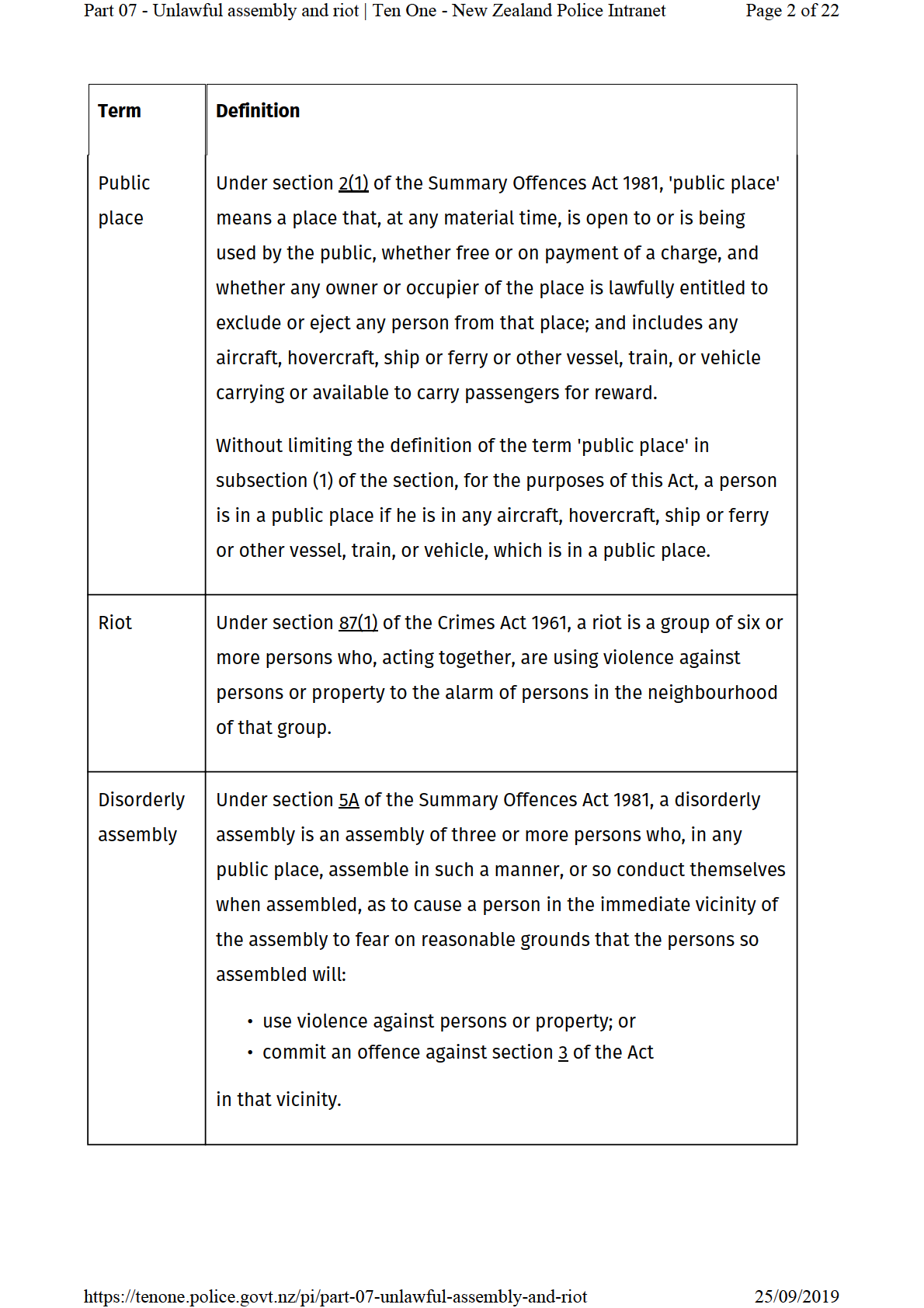

Part 07 - Unlawful assembly and riot | Ten One - New Zealand Police Intranet
Page 4 of 22
• in or within view of any public place
• behaved, or incited or encouraged any person to behave
• in a riotous, offensive, threatening, insulting, or disorderly manner
• that was likely in the circumstances to cause violence against persons or
property to start or continue.
What is 'riotous'?
Riotous behaviour involves force or violence that is likely to cause alarm in a person
of reasonable firmness and courage -
Scott v Parkinson & Howard (1912) V L R 389
refers.
Riotous behaviour is more serious than disorderly behaviour, but falls short of the
crime of riot. Because it is also disorderly behaviour, it will rarely be filed as a
charge.
Riot
You must prove the identity of the suspect and that they:
• were a member of a group of six or more persons who:
◦ acting together,
◦ were using violence against persons or property
◦ to the alarm of persons in the neighbourhood of that group.
What is 'acting together'?
'Acting together' means having a purpose common to all the participants in the
group -
R v Ruru (1989) 4 CRNZ () 526 refers.
Riotous damage
You must prove the identity of the suspect and that they:
• being a member of a riot,
• unlawfully damaged any property.
In
Campbell v Police, it was decided that a person is reckless if he has "a conscious
appreciation of the danger or risk of damage if he continues with the course of
conduct but proceeds nevertheless" -
Campbell v Police (unreported, High Court
Dunedin, 18 November 1983, M143/83) refers.
Unlawful assembly
You must prove the identity of the suspect and that they were a member of an
assembly of three or more people who:
https://tenone.police.govt.nz/pi/part-07-unlawful-assembly-and-riot
25/09/2019
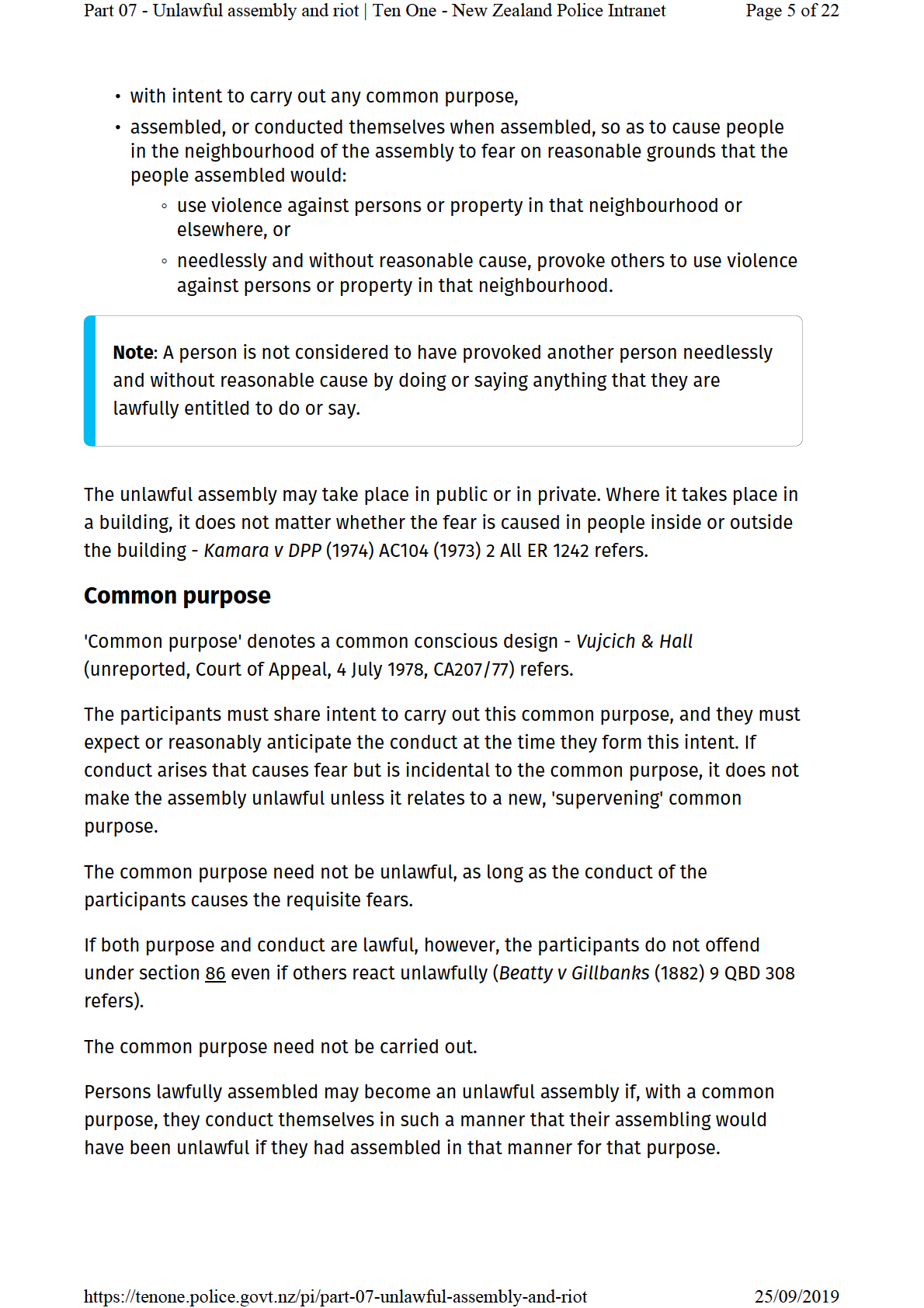
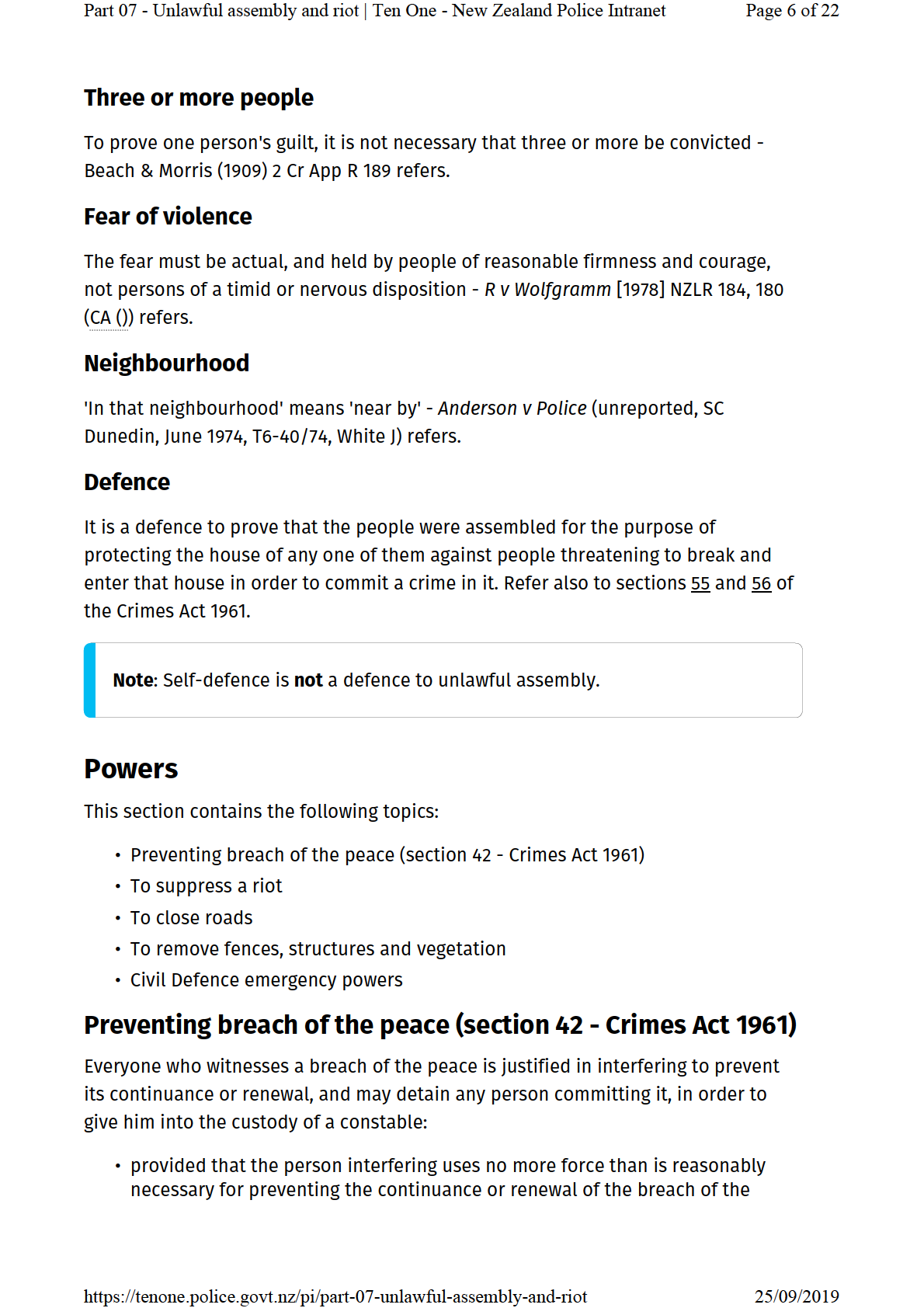
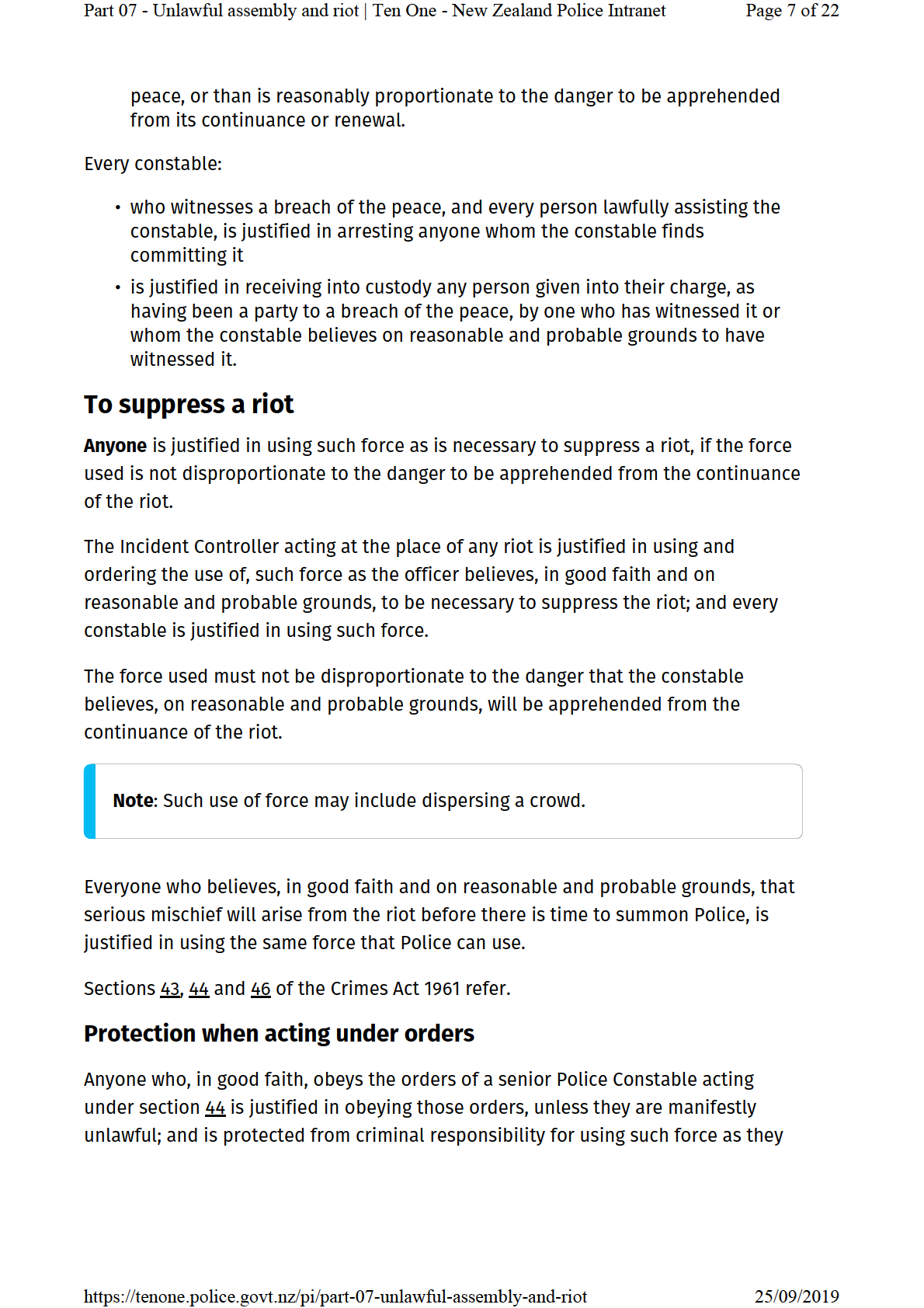
Part 07 - Unlawful assembly and riot | Ten One - New Zealand Police Intranet
Page 8 of 22
believe, on reasonable and probable grounds, to be necessary for carrying those
orders into effect. Whether a particular order is manifestly unlawful is a question of
law.
Anyone bound as a member of the New Zealand defence forces to obey the lawful
command of a superior officer is justified in obeying any command given to them by
such an officer for the suppression of a riot, unless the command is manifestly
unlawful. Whether a particular command is manifestly unlawful is a question of law.
Sections 45 and 47 of the Crimes Act 1961 refer.
To close roads
You have the power to temporarily close roads to traffic under section 35 of the
Policing Act 2008. Consider exercising this power in cases of unlawful assemblies,
gang confrontations and other kinds of serious public disorder. Reopen the road as
soon as practicable.
Note:
'Road' includes a motorway, a public road, a private road and a private way.
'Temporarily' means for a period that is reasonably necessary in the circumstances.
'Traffic' means all or any specified type of traffic (including pedestrian traffic).
'Road Block' is a notification for Police wishing to close a road if they suspect on
reasonable grounds that there is in or on any vehicle any person who:
• has committed an offence punishable by 7 years or more imprisonment or
• is unlawfully at large.
To remove fences, structures and vegetation
Under section 216 of the Local Government Act 2002 you can apply to a district court
for a removal order requiring the owner or occupier of any property to remove or
alter any fence, structure or vegetation. The court can make such an order if it is
satisfied that:
• the property is occupied, or regularly used, by people who have been
convicted of, or have committed, or are committing, or are likely to commit,
offences; and
• the fence, structure or vegetation has facilitated or contributed to, is
facilitating or contributing to, or is intended to facilitate or contribute to:
https://tenone.police.govt.nz/pi/part-07-unlawful-assembly-and-riot
25/09/2019
Part 07 - Unlawful assembly and riot | Ten One - New Zealand Police Intranet
Page 9 of 22
◦ the concealment on the property of any unauthorised weapon or any
controlled drug or any tainted property or any property that is stolen or
obtained by a crime involving dishonesty; or
◦ the avoidance of detection or arrest of any person believed or
reasonably suspected to have committed any offence; or
◦ the commission of any offence by any person on or from the property;
or
• is intended to injure any person.
What you can do further
If the respondent does not comply with the removal order, you can, without further
notice and using such force as is reasonable in the circumstances, enter:
• the place where the fence, structure or vegetation is situated, and
• if reasonably necessary and if authorised by the court in the removal order,
any portion of the adjoining land, to remove or alter the fence, structure or
vegetation, or arrange for its removal or alteration in accordance with the terms of
the removal order.
Note: Section 220 of the Local Government Act 2002 refers.
Duty
Under section 221 of the Local Government Act 2002 you must:
• enter at reasonable times, and
• carry with you and produce on initial entry, if required to do so, evidence of
your authority to enter and of your identity; and
• as soon as practicable after the entry, give the owner and the occupier notice
in writing, in the prescribed form and manner, of the entry and the reasons for
it.
Civil Defence emergency powers
See the 'Civil Defence and Emergency Management' chapter for your powers under
the Civil Defence Emergency Management Act 2002.
Duties and responsibilities
This section contains the following topics:
• Operation Commander
• Initially
https://tenone.police.govt.nz/pi/part-07-unlawful-assembly-and-riot
25/09/2019
Part 07 - Unlawful assembly and riot | Ten One - New Zealand Police Intranet
Page 10 of 22
• During the operation
• After the operation
• Second in Charge (2 I/C)
• Scene Commander
Operation Commander
The Operation Commander is responsible to the District Commander. If the
operation crosses district boundaries, the Operation Commander must liaise with
the District Commanders involved. The Operation Commander should:
• direct, co-ordinate and control the operation
• appoint a liaison officer
• appoint an O/C Logistics
• appoint a Deputy Operation Commander, if necessary
• make a full appreciation of the situation
• give regular SITREPs to the District Commander
• establish policy on media releases.
Initially
During the initial stages of the operation, plan:
• the command structure and the expertise needed to make it work
• the format and content of orders groups and briefings (if you appoint a
briefing officer you can concentrate on command)
• liaise with the District Command Centres for initial information and staffing
resources available
• intelligence gathering and analysis (for major operations, discuss this with the
O/C, District Intelligence Section)
• the involvement of the district engineering services technician in
communications planning
• a media liaison policy that sets out clearly who is permitted to make
statements (consult District Communications Manager or Public Affairs Group,
PNHQ ())
• the appointment of an Intelligence officer to supervise observation staff - Field
Intelligence Officers , CIB () or uniformed employees in plain clothes - who will
mix with the crowd, noting and or visually recording anything of concern and
gathering evidence
• staff deployment boards and plotting tables
• support staff and logistic help (tell the District Commander your requirements
as soon as possible so that arrangements can be made)
https://tenone.police.govt.nz/pi/part-07-unlawful-assembly-and-riot
25/09/2019
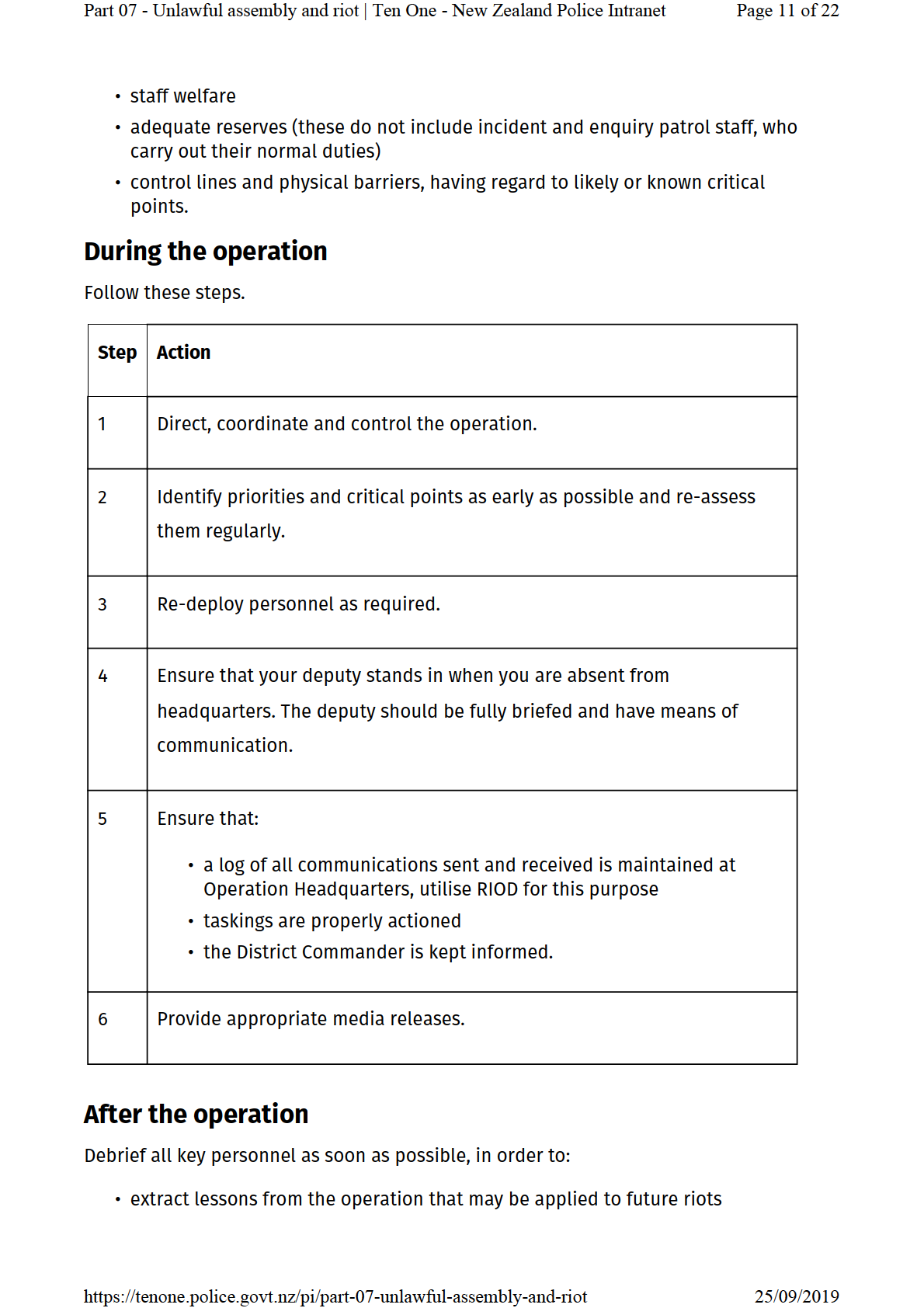
Part 07 - Unlawful assembly and riot | Ten One - New Zealand Police Intranet
Page 12 of 22
• recommend to the NM: Response and Operations, PNHQ, any necessary
alterations to Police Instructions.
When large numbers are involved, O/C sections and other employees whose
attendance is considered unnecessary could use a debrief form prepared in
advance. In any event, supervisors should debrief their own personnel. See
'Debriefs' chapter.
Any equipment and vehicles used for the operation must be returned. This is the
responsibility of the O/C Logistics.
For details on logistics, see the 'Logistics' chapter.
Second in Charge (2 I/C)
The 2 I/C is responsible to the Operation Commander and should establish the
operation headquarters and achieve its objectives.
For more information on a 2 I/C's duties, see the 'Operation Headquarters' chapter.
Scene Commander
The Scene Commander is responsible to the Operation Commander and:
• directs, coordinates and controls Police activities at the scene
• is responsible for briefing group commanders
• ensures that there is a high degree of teamwork.
The Scene Commander must:
• establish an accessible Forward Command Headquarters, preferably
overlooking the event (a mobile headquarters with communications may be
necessary for mobile demonstrations)
• staff the headquarters adequately - it must be guarded by personnel or Police
dogs and have a communicator and log keeper
• ensure that a deputy stands in when the Scene Commander is absent from the
headquarters (the deputy must be fully briefed and have means of immediate
communication)
• deploy personnel early to ensure that the demonstrators follow the
designated route and do not create disorder or commit other offences
• make available equipment such as bins, barricades, ropes, floodlights, loud
hailers, binoculars, situation maps, fire extinguishers, and bolt cutters
• establish early communication with other emergency services, such as the Fire
and Ambulance Services.
See the 'Multi-agency response to incidents' chapter for further information.
https://tenone.police.govt.nz/pi/part-07-unlawful-assembly-and-riot
25/09/2019
Part 07 - Unlawful assembly and riot | Ten One - New Zealand Police Intranet
Page 13 of 22
The objectives of Police action in riot situations
This section contains the following topics:
• Evaluation
• Mobilisation
• Tactics
• Security
Evaluation
Proper deployment in the initial stages of a riot may contain or reduce violence, but
time is critical. The senior police officer at the scene must think ahead, comparing
the time required to mobilise resources with the rate at which the situation is likely
to escalate.
Note: For information on making an appreciation, see the 'Planning, control and
command' chapter.
Mobilisation
The first Police at the scene should adopt defensive tactics to contain the riot until
sufficient resources arrive to suppress it. The scene should be secured as quickly as
possible on an area by area, section by section basis, with consideration given to
the direction in which the riot is likely to spread. Communications must be
established as soon as possible and relayed continuously.
Note: While some riots develop gradually, others may erupt almost instantaneously.
For this reason, the necessary procedures must be established before the event,
where possible.
Tactics
The tactics used to deal with the riot will be determined by the cause of the riot, the
reasons for its continuance, who is involved and what is being done by those
involved in the riot.
Security
When the riot has been dealt with, the scene must be adequately patrolled.
Also see the 'Introduction to Public Order Management', 'Public Order Intervention
Model', 'Warning Messages' and 'Out of Control Gatherings' parts of this chapter.
Policing a riot
https://tenone.police.govt.nz/pi/part-07-unlawful-assembly-and-riot
25/09/2019
Part 07 - Unlawful assembly and riot | Ten One - New Zealand Police Intranet
Page 14 of 22
This section contains the following topics:
• Tactics
• Oleoresin capsicum spray
• Taser
• Security
• Protective equipment
• Batons
• Police dogs
• Intelligence gathering
• Evidence gathering
When policing a riot, work as a team. No matter how skilled you may be, you will be
relatively ineffective if you try to work as an individual. Remember that any wrong
decision could dramatically influence the course of events.
Important: Staff safety is paramount.
Tactics
There is no single tactic for dealing with violent situations. The Operation or Scene
Commander must consider:
• TENR
• Public Order Intervention Model
• the nature and extent of the riot
• the persons involved in the riot
• the safety or persons and property not part of the riot
• the safety of Police and other emergency services
• general tactics to regain control
• the means and resources required/available to implement those tactics.
Negotiation can be useful when the situation involves people from a particular
ethnic or social background and is part of an ongoing protest, provided that delay in
Police action does not result in death or injury. However, your response will
inevitably involve one or more of the following tactics.
Containment
Assemble sufficient trained personnel to hold the demarcation line, and supply
them with protective equipment. Where necessary, deploy additional groups so that
a leapfrog advance can be made to hold any ground won. All constables used must
https://tenone.police.govt.nz/pi/part-07-unlawful-assembly-and-riot
25/09/2019
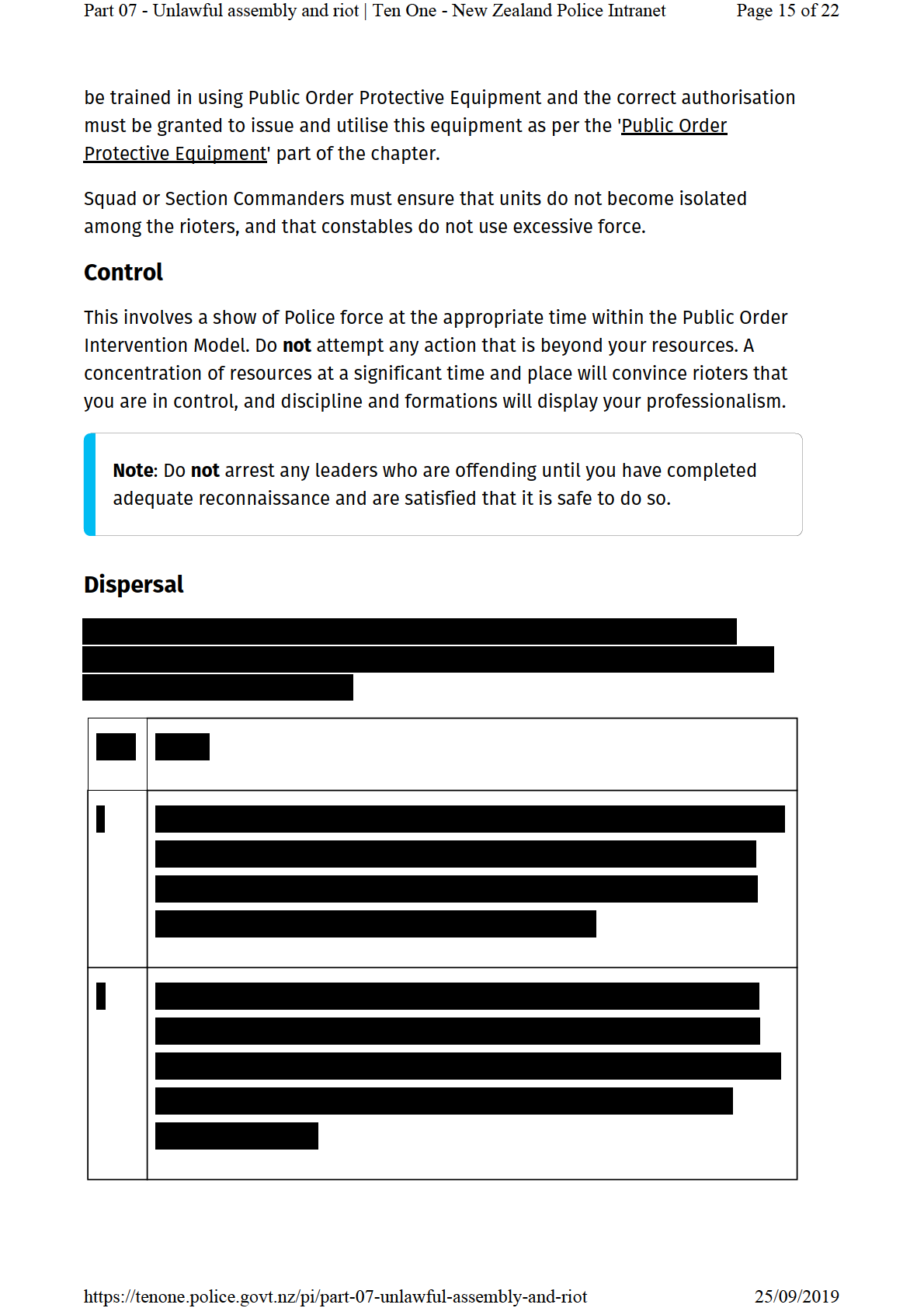

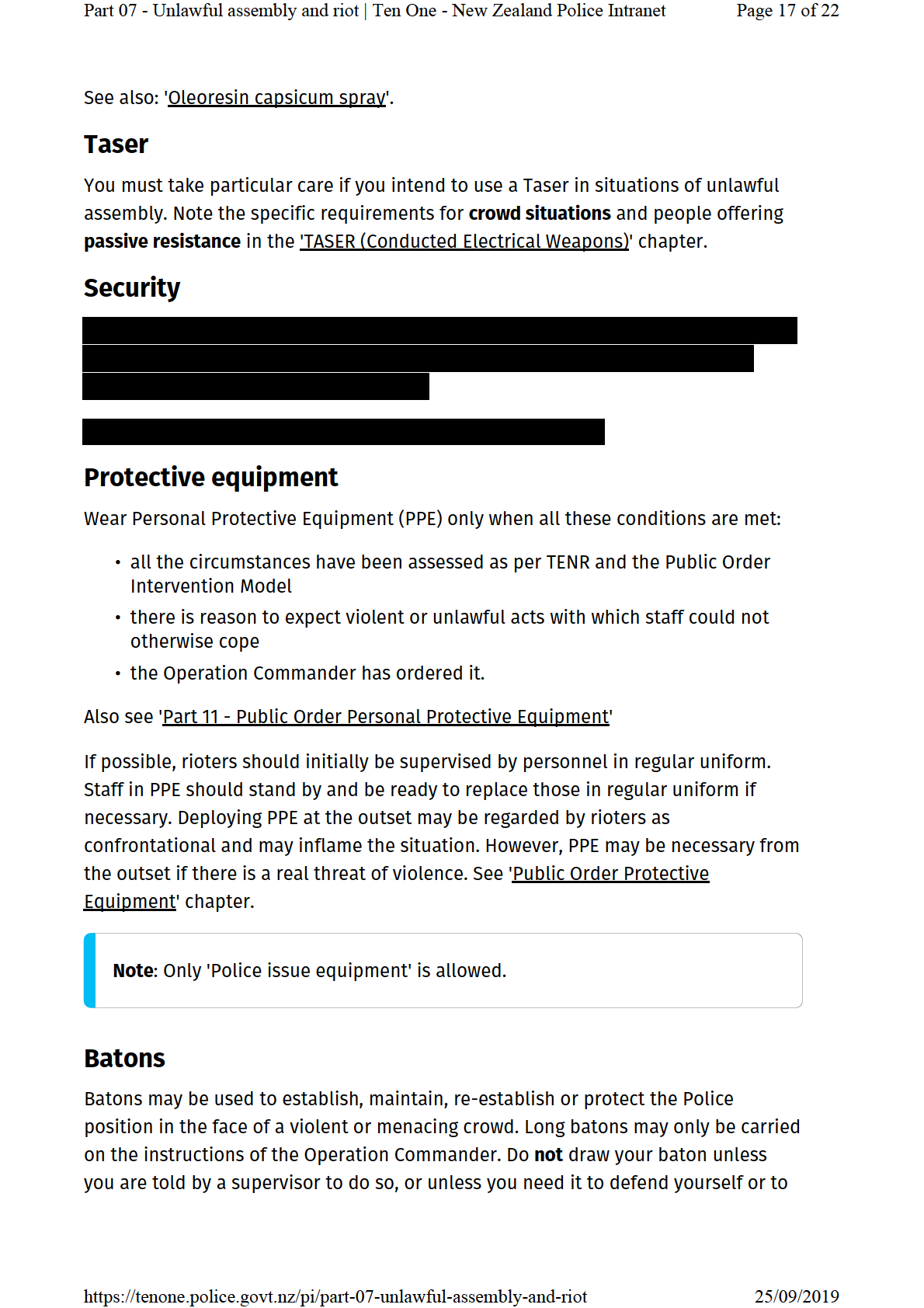
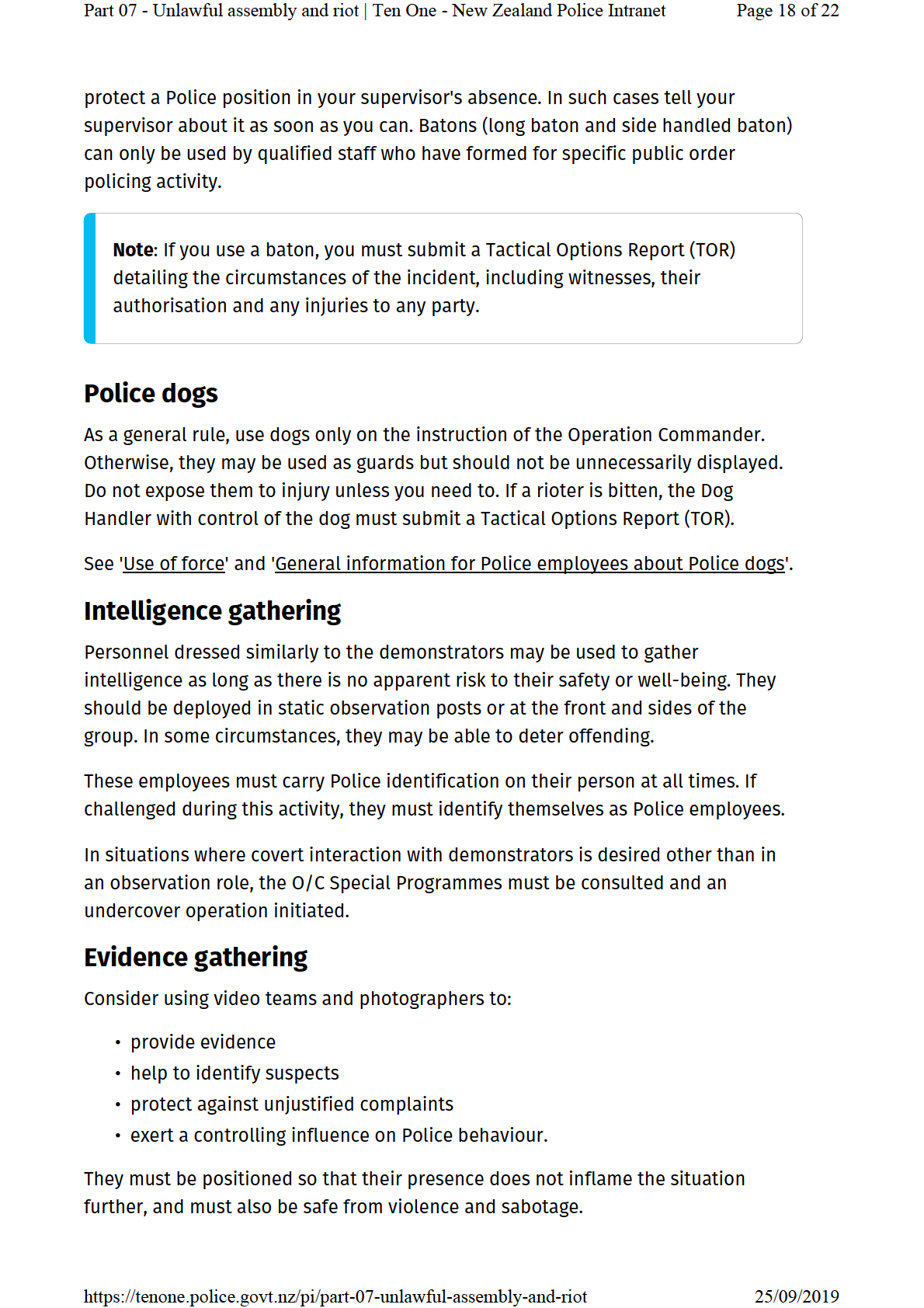
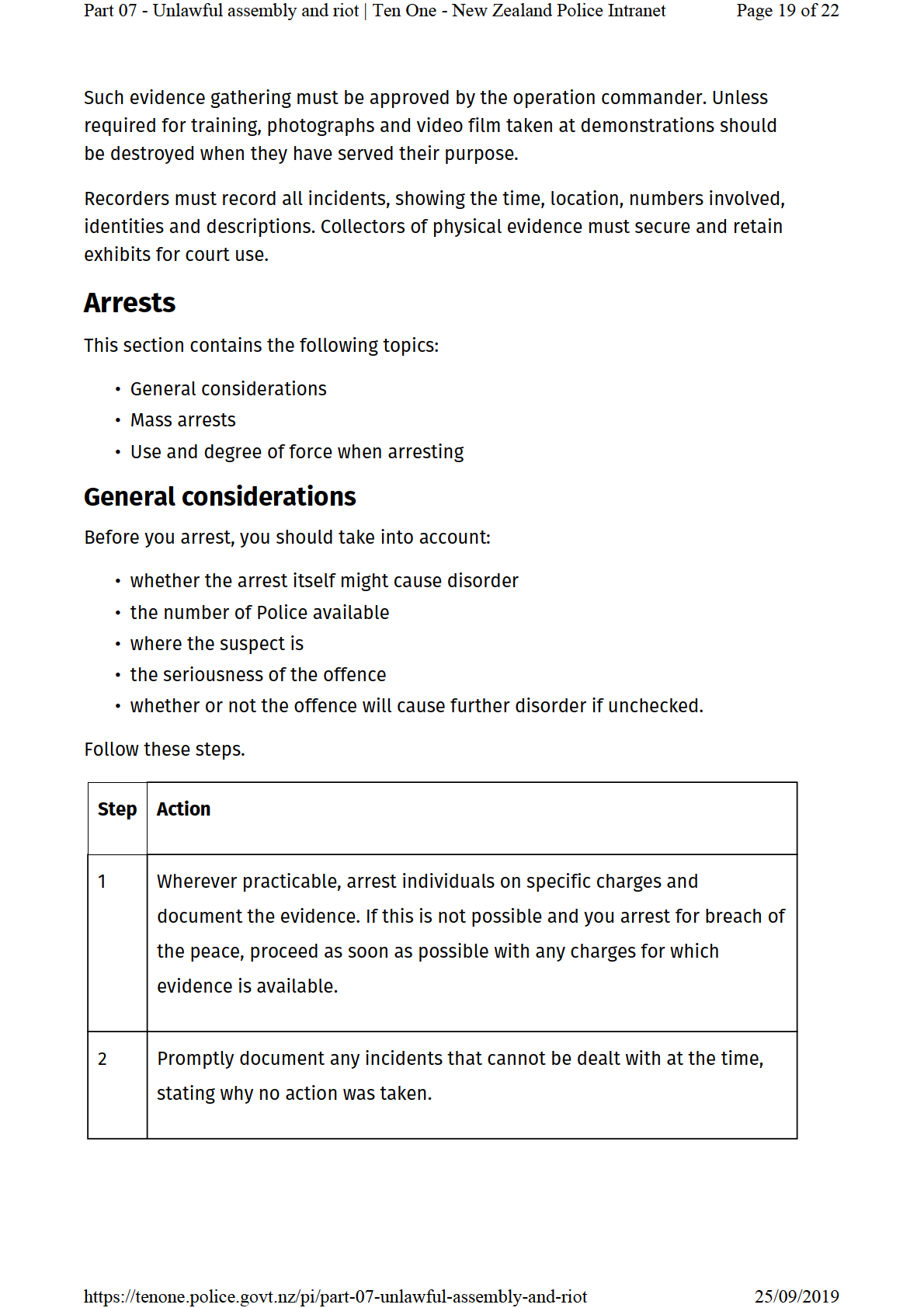
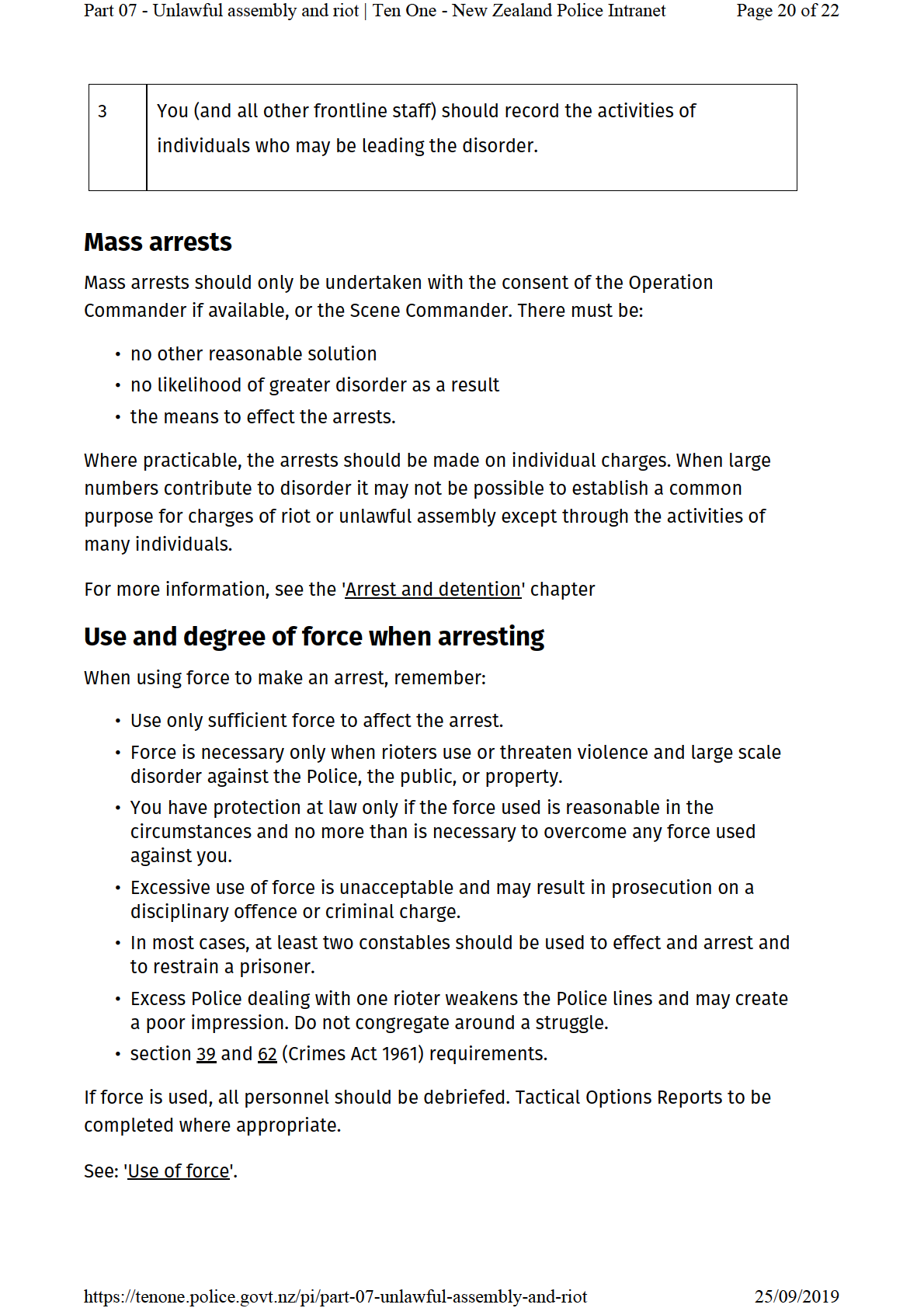
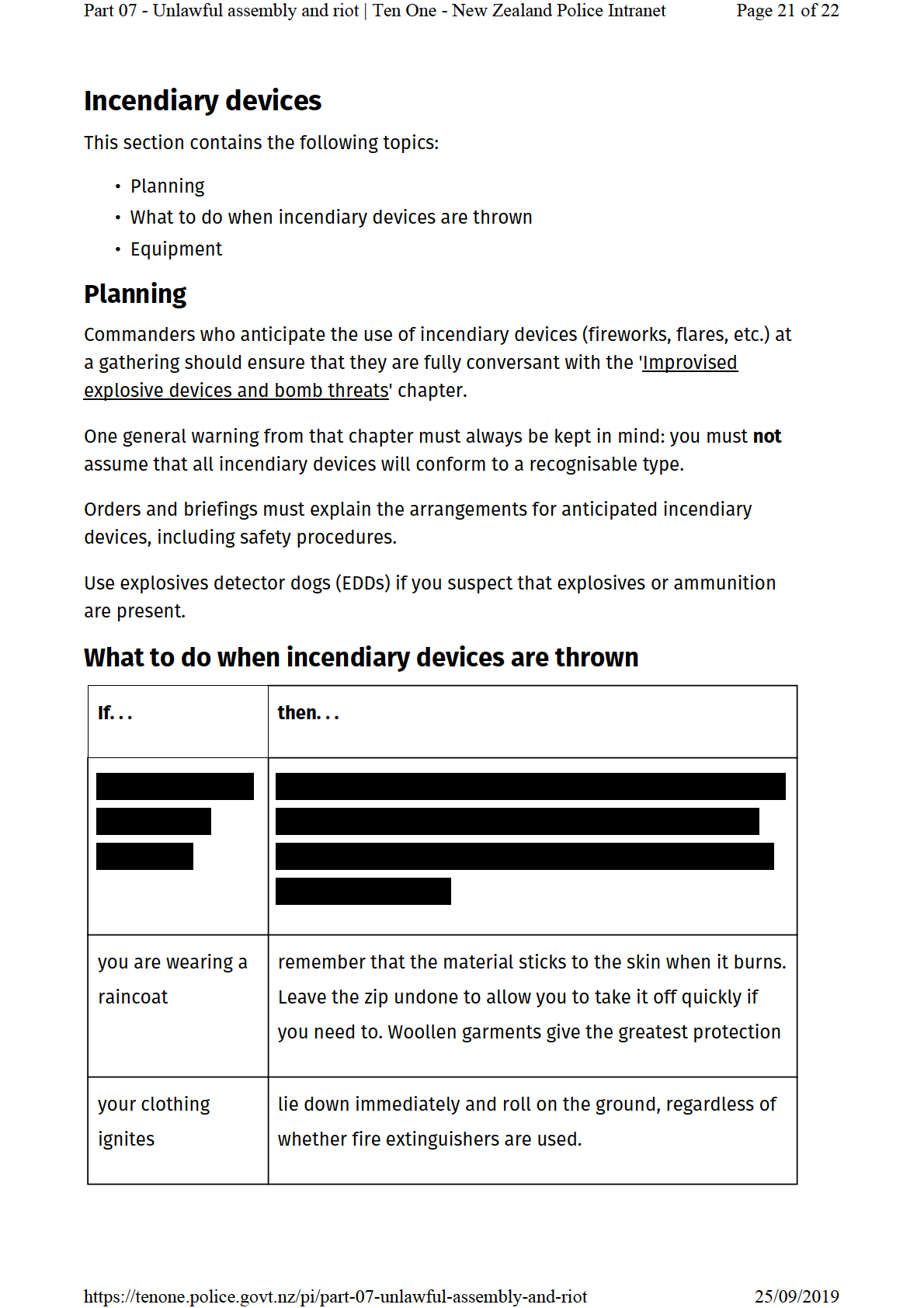
Part 07 - Unlawful assembly and riot | Ten One - New Zealand Police Intranet
Page 22 of 22
Equipment
Constables exposed to incendiary devices should be supported by Logistics
personnel and/or emergency services (i.e. fire and ambulance) with:
• a dry powder fire extinguisher
• a B.C.F. chemical extinguisher (these are effective against incendiary devices
that generate their own oxygen - if you don't know what kind of device has
been used, try dry powder first)
• asbestos gloves
• clean water, for rinsing eyes
• 'Gladiator' and long shields (these are useful against fire and help to deflect
incendiary devices).
https://tenone.police.govt.nz/pi/part-07-unlawful-assembly-and-riot
25/09/2019












